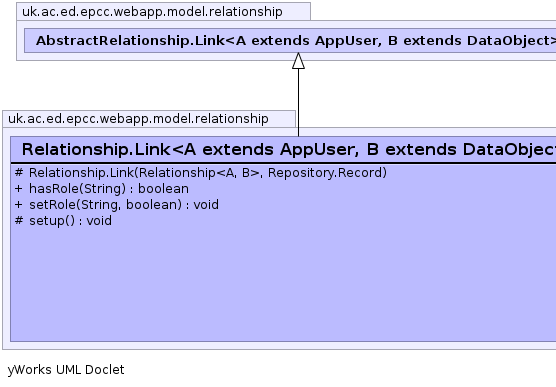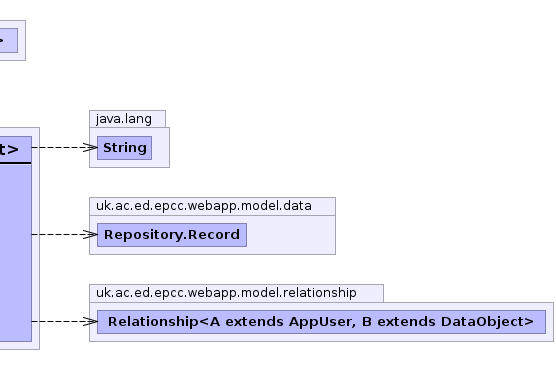- java.lang.Object
-
- uk.ac.ed.epcc.webapp.model.data.DataObject
-
- uk.ac.ed.epcc.webapp.model.data.IndexedLinkManager.Link<L,R>
-
- uk.ac.ed.epcc.webapp.model.data.LinkManager.Link<A,B>
-
- uk.ac.ed.epcc.webapp.model.relationship.AbstractRelationship.Link<A,B>
-
- uk.ac.ed.epcc.webapp.model.relationship.Relationship.Link<A,B>
-
- All Implemented Interfaces:
- UIGenerator, Contexed, ContextIndexed, Identified, Indexed, Owned, Releasable
- Enclosing class:
- Relationship<A extends AppUser,B extends DataObject>
public static class Relationship.Link<A extends AppUser,B extends DataObject> extends AbstractRelationship.Link<A,B>
-
-
Field Summary
-
Fields inherited from class uk.ac.ed.epcc.webapp.model.data.DataObject
DEBUG, record
-
Fields inherited from interface uk.ac.ed.epcc.webapp.forms.Identified
MAX_IDENTIFIER
-
-
Constructor Summary
Constructors Modifier Constructor and Description protectedLink(Relationship<A,B> arg0, Repository.Record arg1)
-
Method Summary
All Methods Instance Methods Concrete Methods Modifier and Type Method and Description booleanhasRole(java.lang.String role)voidsetRole(java.lang.String role, boolean value)protected voidsetup()extension point for Link subclasses this method is called when new records are created to initialise subclass fields to sensible default values-
Methods inherited from class uk.ac.ed.epcc.webapp.model.data.LinkManager.Link
addContent, getIdentifier, getLinkManager
-
Methods inherited from class uk.ac.ed.epcc.webapp.model.data.IndexedLinkManager.Link
changeLeft, changeRight, getFactory, getIndexedLinkManager, getLeft, getLeftID, getRight, getRightID, isLeftPeer, isRightPeer, post_commit, pre_commit, release, setCachedLeft, setCachedRight
-
Methods inherited from class uk.ac.ed.epcc.webapp.model.data.DataObject
addToMap, addToMap, addToMap, commit, delete, empty, equals, formUpdate, getContext, getDatabaseService, getFactoryTag, getID, getIdentifier, getLogger, getMap, getMap, getOwningFactory, getRecord, getRecord, getRecord, getSQLContext, getUniqueIdName, hashCode, isLocked, lock, postCreate, setContents, setDirty, setMap, toString
-
-
-
-
Constructor Detail
-
Link
protected Link(Relationship<A,B> arg0, Repository.Record arg1)
-
-
Method Detail
-
setup
protected void setup() throws DataFault, DataExceptionDescription copied from class:IndexedLinkManager.Linkextension point for Link subclasses this method is called when new records are created to initialise subclass fields to sensible default values- Overrides:
setupin classAbstractRelationship.Link<A extends AppUser,B extends DataObject>- Throws:
DataFaultDataException
-
hasRole
public boolean hasRole(java.lang.String role)
- Specified by:
hasRolein classAbstractRelationship.Link<A extends AppUser,B extends DataObject>
-
setRole
public void setRole(java.lang.String role, boolean value)- Specified by:
setRolein classAbstractRelationship.Link<A extends AppUser,B extends DataObject>
-
-

